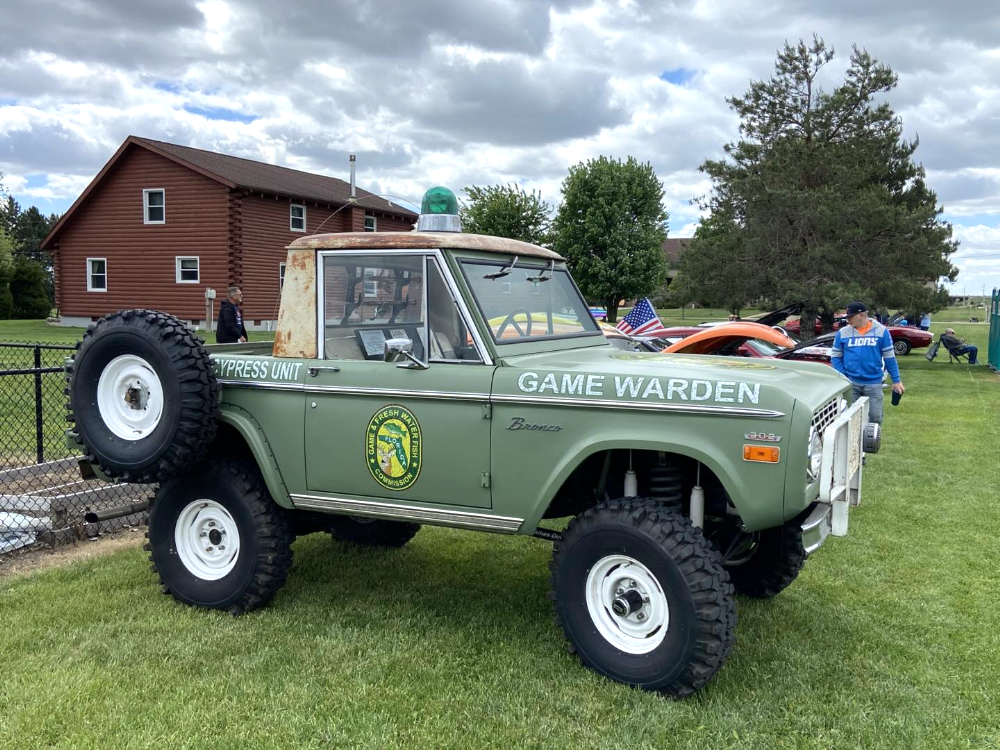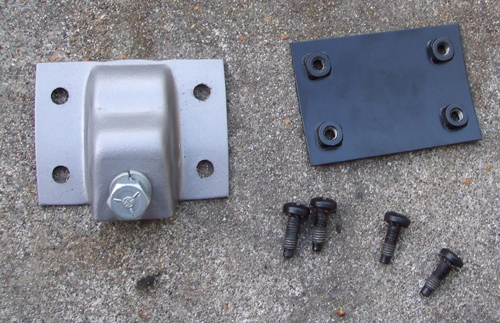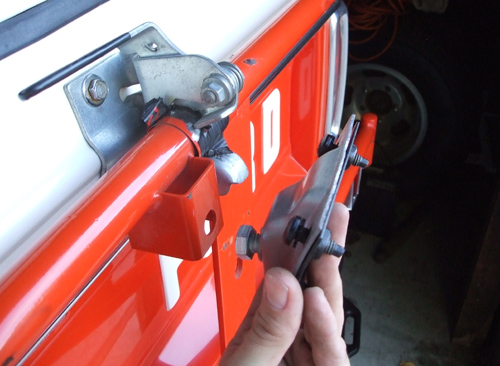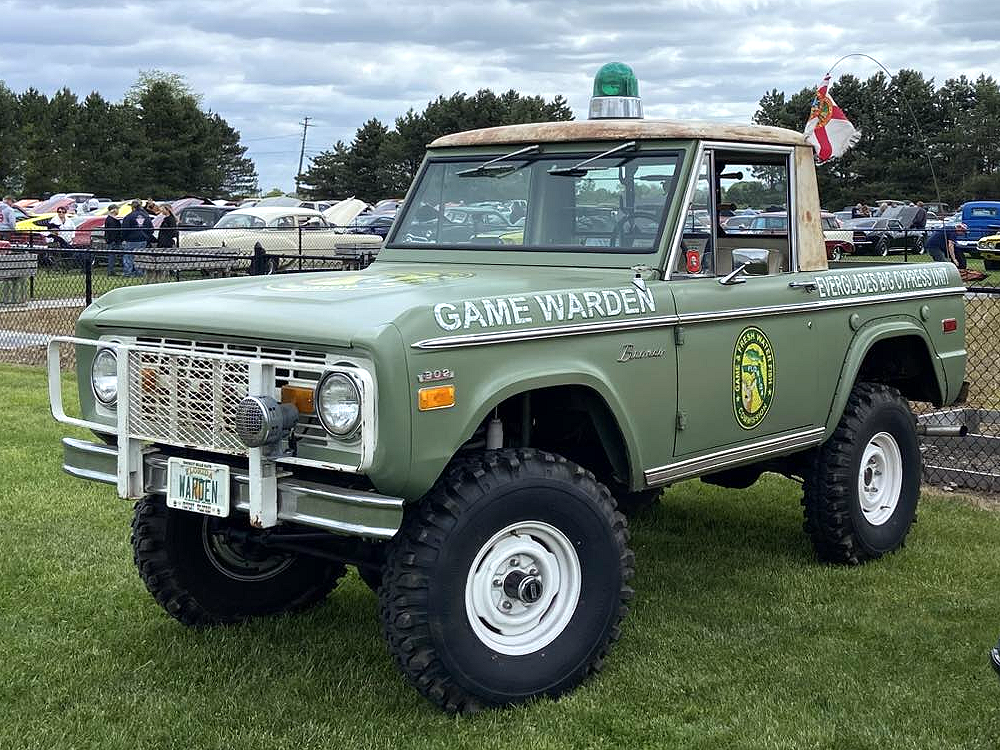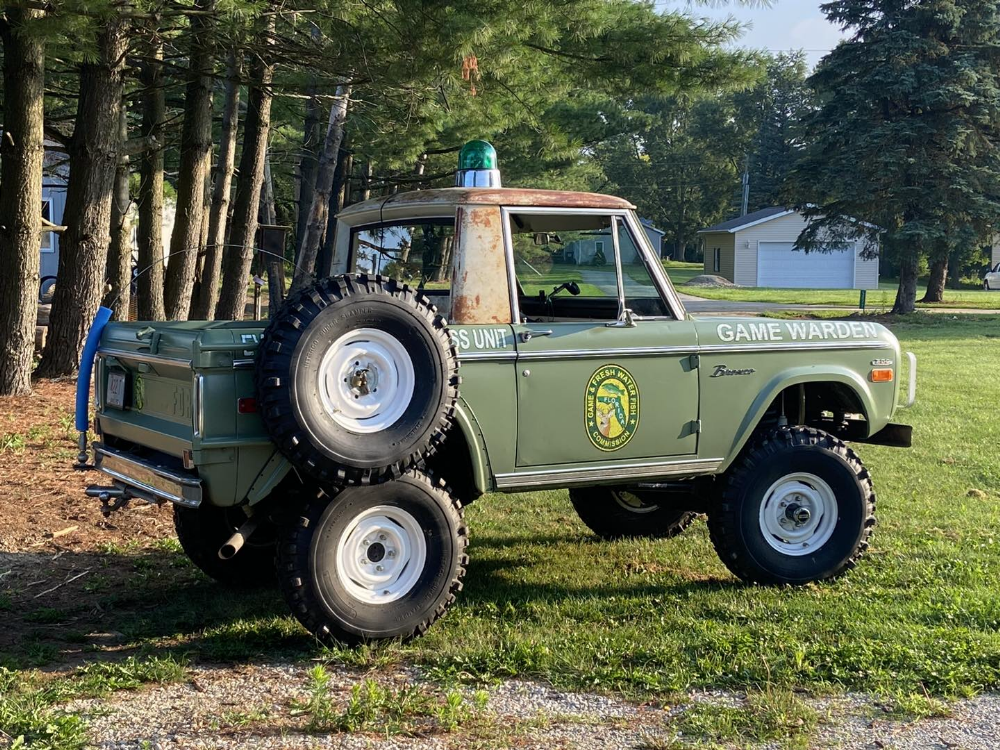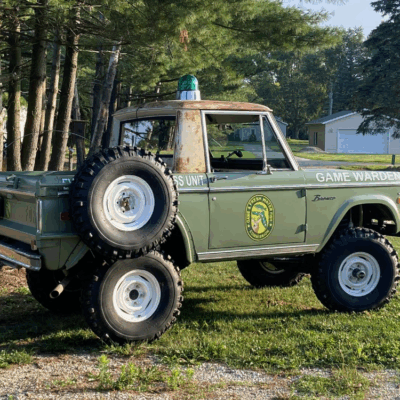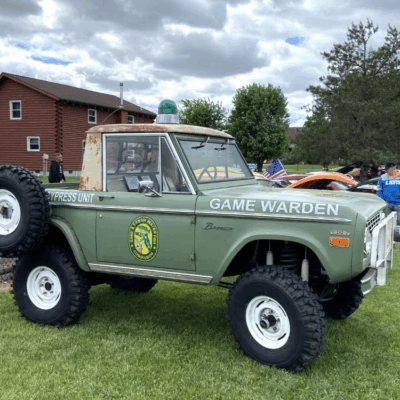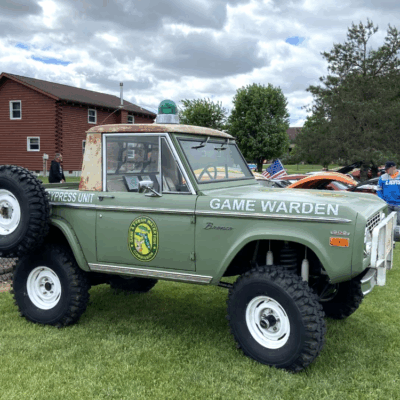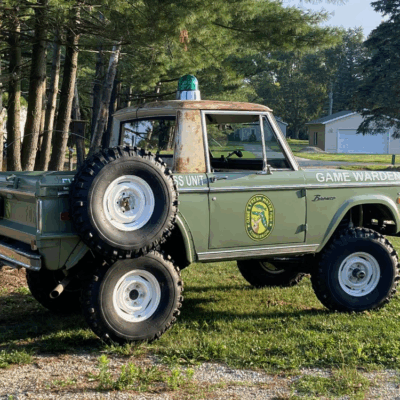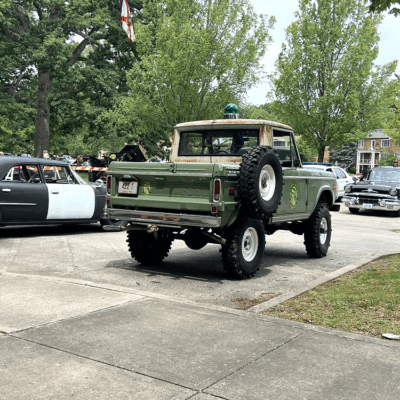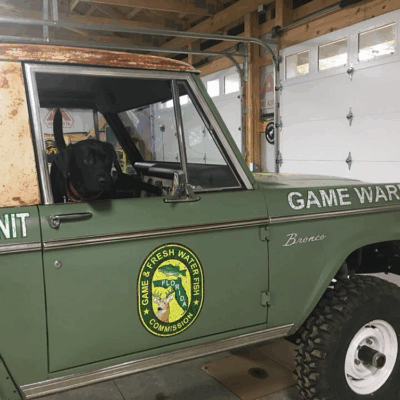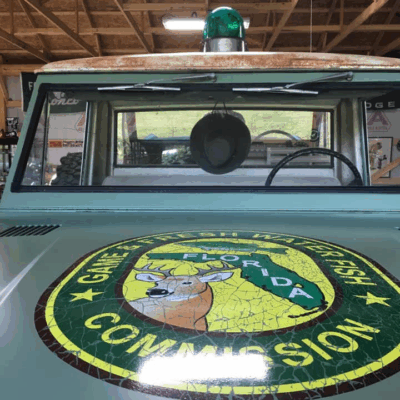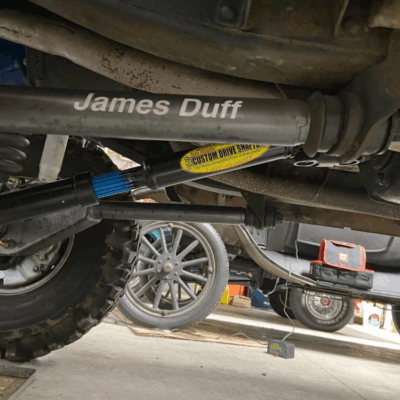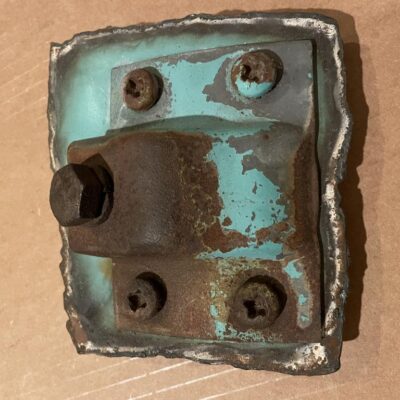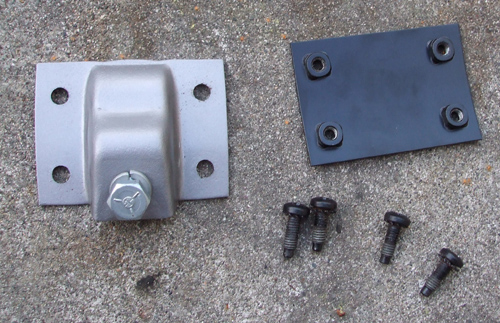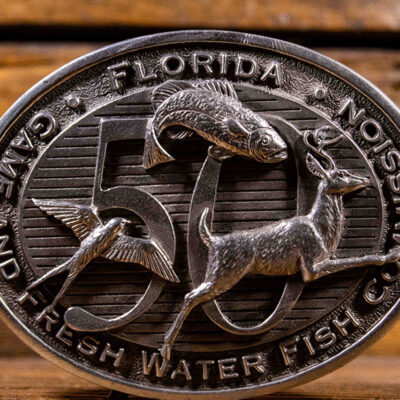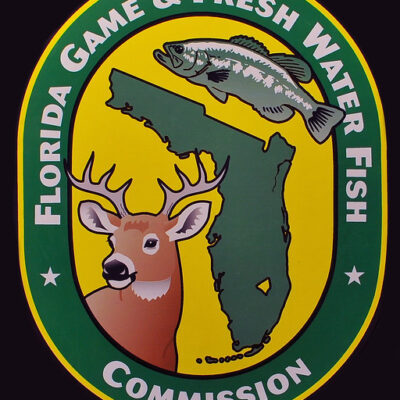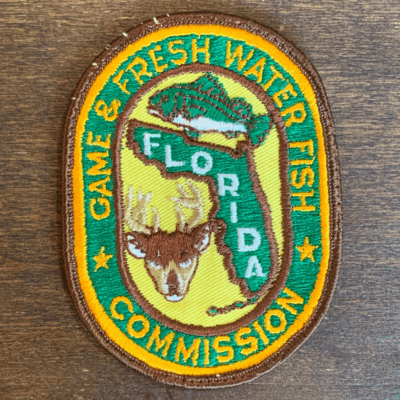This 1970 Ford Bronco was once used by the Florida Game & Fresh Water Fish Commission. Since then, it has found a new home in Ohio, but the owner chose to retain its ‘Game Warden’ livery.
The Bronco received a James Duff suspension lift that included a dual front shock setup and extended radius arms. The lift makes room for the 34×9.5-15 Interco Super Swampers. I like that they’re mounted on white steel wheels to retain the period correct vibe of the vehicle. A Tom Woods driveshaft gets the power from the transfercase to the wheels.
Speaking of period correct, the Bronco also features a mechanical siren mounted to the white steel brush guard, and a Federal Signal Beacon Ray Model 173 emergency light on the roof. The light was most likely blue back in 1970, but the law enforcement agencies in Ohio probably wouldn’t be a fan of it. Not only does the green beacon look great on the green Bronco, it also won’t attract any unwanted attention.
For those of you curious about the spare tire mounted to the side of the vehicle; that’s a ‘Ranch Hand’ mount.
The mount bolts through the side of the vehicle to a backing plate. The spare tire is moved from the outside of the swing-out tire carrier to the inside and then the tire carrier is bolted to the new mount. The idea is so you can haul things with the tailgate down and not have the spare tire in the way.
I dig the look of this thing. I hope the owner keeps it this way.
Florida Game and Freshwater Fish Commission (GFC)
The Florida Game and Freshwater Fish Commission (GFC) was a state agency responsible for managing and conserving Florida’s freshwater fish and wildlife resources. It existed from 1943 until 1999, when it was merged into the Florida Fish and Wildlife Conservation Commission (FWC), a broader agency that exists today.
Overview: What the GFC Was and Did
Established: 1943
Dissolved/merged: 1999 (into FWC)
Jurisdiction: State of Florida
Primary Role: Conservation, management, and regulation of:
- Freshwater fish
- Game animals (such as deer, turkey, and quail)
- Non-marine wildlife
- Hunter and angler licensing and regulation
- Wildlife law enforcement
Functions and Responsibilities
The GFC was charged with:
- Setting hunting and fishing seasons and limits
- Issuing licenses for fishing and hunting
- Managing freshwater fisheries
- Enforcing wildlife laws through its own sworn law enforcement officers
- Habitat management for freshwater species and game animals
- Public education and outreach
- Captive wildlife permits and regulation
The agency operated a number of fish hatcheries, conducted biological surveys, and worked with landowners and local governments to promote wildlife conservation practices.
History and Evolution
Before GFC (pre-1943)
Florida’s fish and game were managed by the State Board of Conservation and, before that, by county game wardens and various local laws. There was little uniformity, and wildlife enforcement was often underfunded and inconsistent.
Creation of the GFC (1943)
In 1943, the Florida Legislature created the Game and Fresh Water Fish Commission as a constitutionally independent agency, meaning it did not report directly to the governor or legislature but instead operated under its own authority. This unusual autonomy allowed it to make science-based decisions about wildlife management without as much political interference.
It was run by a five-member commission appointed by the governor, who oversaw an executive director and staff of biologists, law enforcement officers, and administrators.
Major Milestones
- 1950s–60s: Expansion of fish hatchery programs and wildlife law enforcement.
- 1970s: Growing environmental awareness led to more comprehensive management strategies.
- 1980s–90s: Increasing attention to habitat preservation, endangered species (e.g., Florida panther, black bear), and non-game wildlife.
- GFC officers gained statewide law enforcement authority over wildlife laws and often cooperated with other agencies like the Florida Marine Patrol and U.S. Fish & Wildlife Service.
Merger into FWC (1999)
In 1998, Florida voters approved a constitutional amendment (Article IV, Section 9) to merge the Florida Marine Fisheries Commission, Florida Department of Environmental Protection’s marine resources, and the GFC into a single, comprehensive agency:
The Florida Fish and Wildlife Conservation Commission (FWC) began operations on July 1, 1999, assuming all duties of the GFC.
This merger created a unified agency with jurisdiction over both freshwater and saltwater wildlife, reflecting Florida’s complex ecosystems that span inland rivers, lakes, coastal estuaries, and marine environments.
Legacy and Impact
The Florida GFC was considered a pioneer in professional wildlife management, especially in the South. It helped develop:
- Modern wildlife law enforcement in Florida
- Scientific wildlife population monitoring
- Angler-supported conservation through license sales and federal excise taxes (Pittman-Robertson and Dingell-Johnson Acts)
- Conservation areas and wildlife management areas (WMAs) across the state
Many of today’s wildlife conservation strategies in Florida were built on foundations laid by the GFC.
Interesting Notes
- The GFC issued its own branded publications, including hunting and fishing guides, educational materials, and biological reports.
- It operated Wildlife Officers Training Academies to professionalize wildlife law enforcement.
- Some of its early enforcement officers were veterans or former military personnel and played key roles in protecting species like alligators and manatees.
Photo Gallery
About The Author
Welcome to the Bronco Corral. As a long time Ford Truck enthusiast, I've been a fan of the Ford Bronco and Bronco II. In fact, I've completely rebuilt a Bronco II of my own. The Bronco Corral originally started as the Bronco II Corral, but in 2020 I decided to expand it to include all Ford Bronco's, and welcome the upcoming 2021 Ford Bronco. Thanks for stopping.

